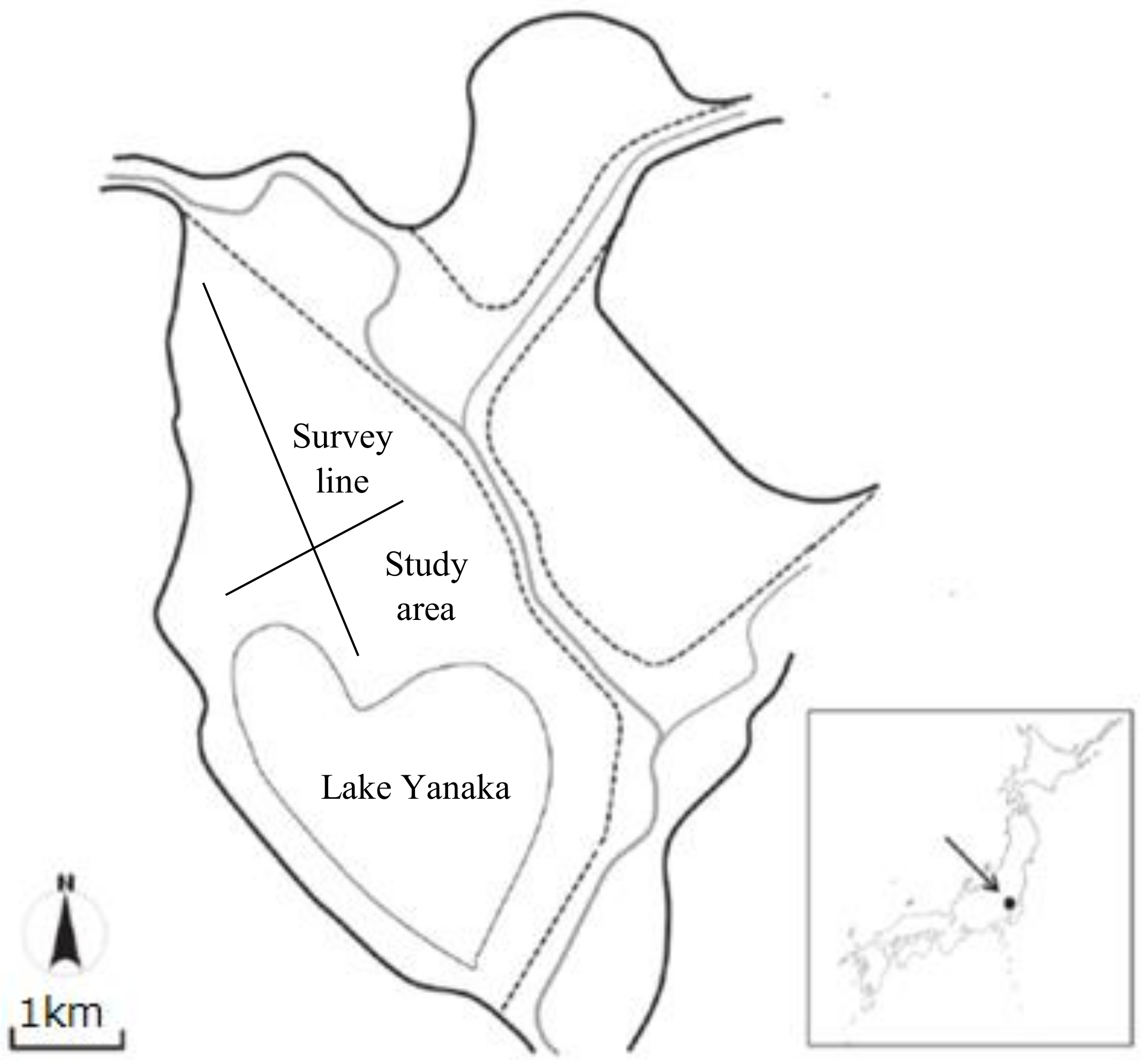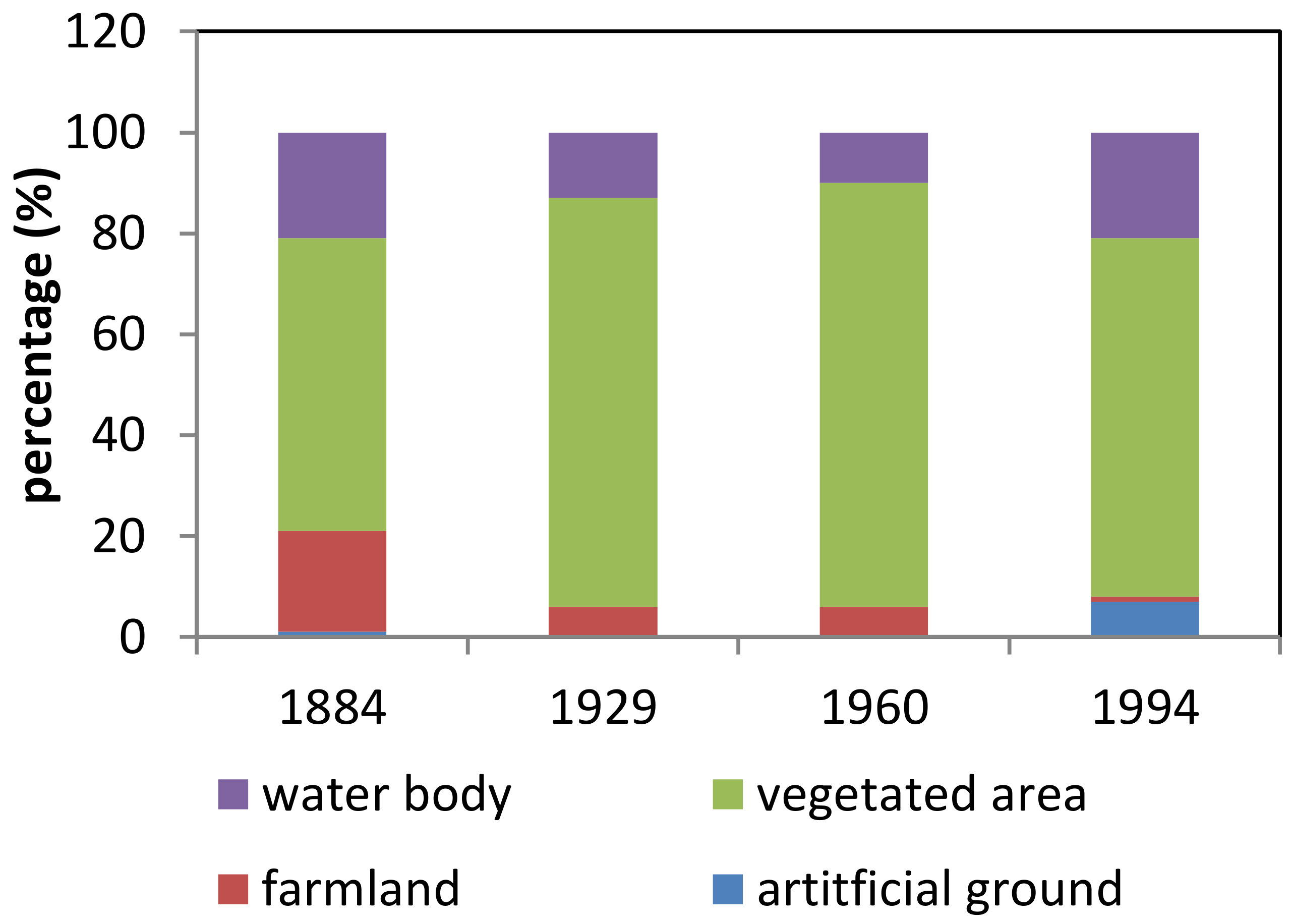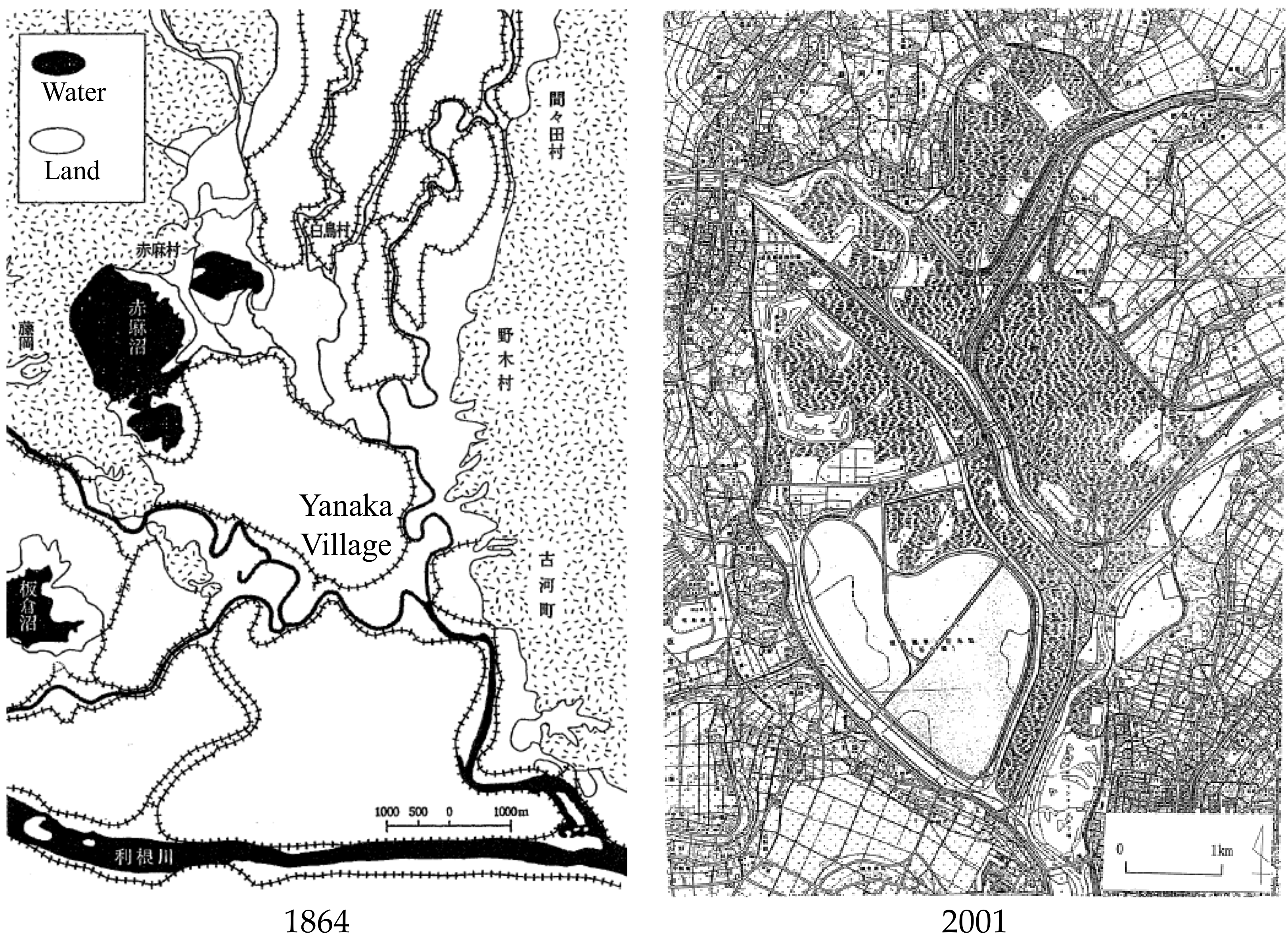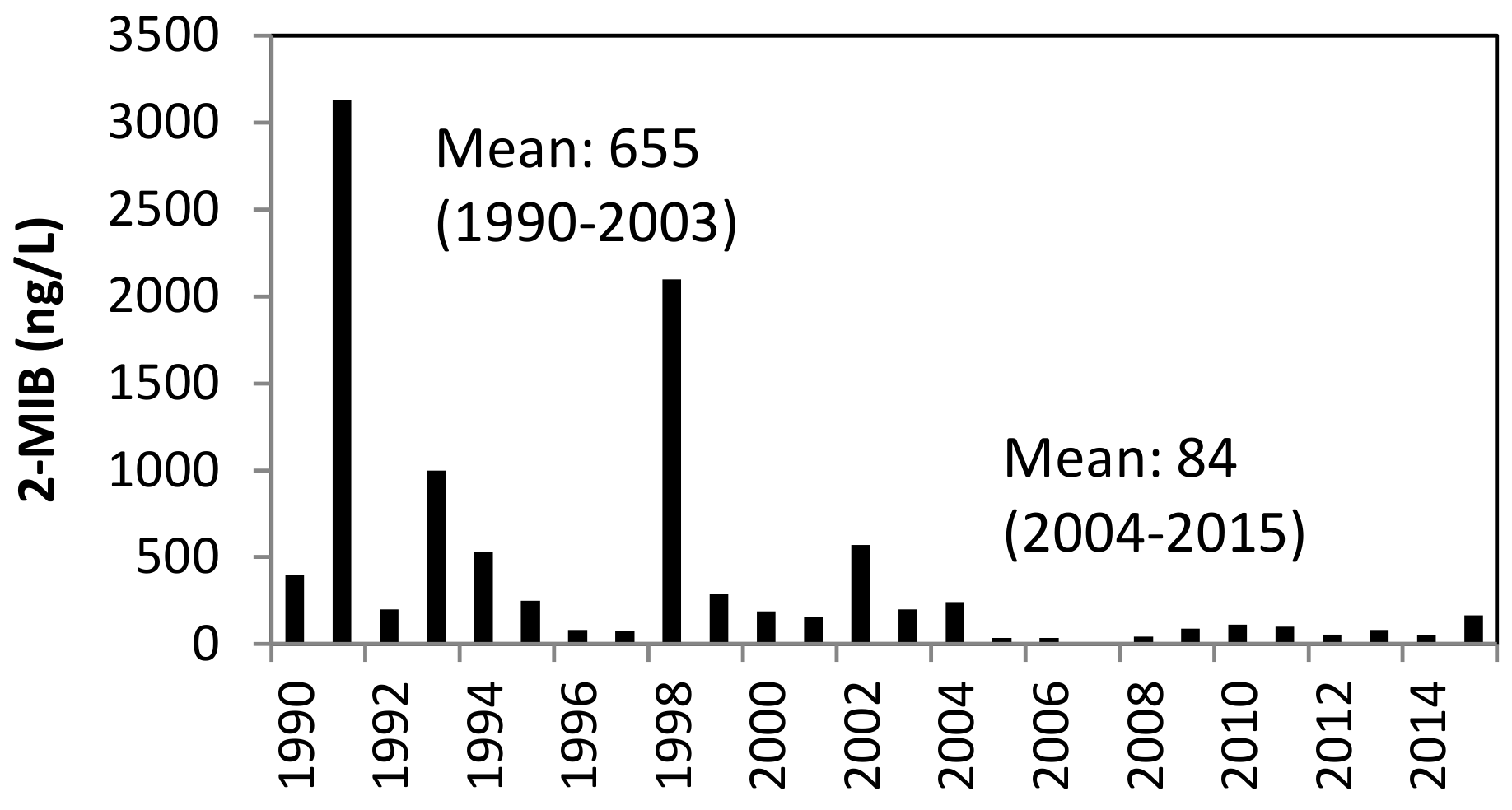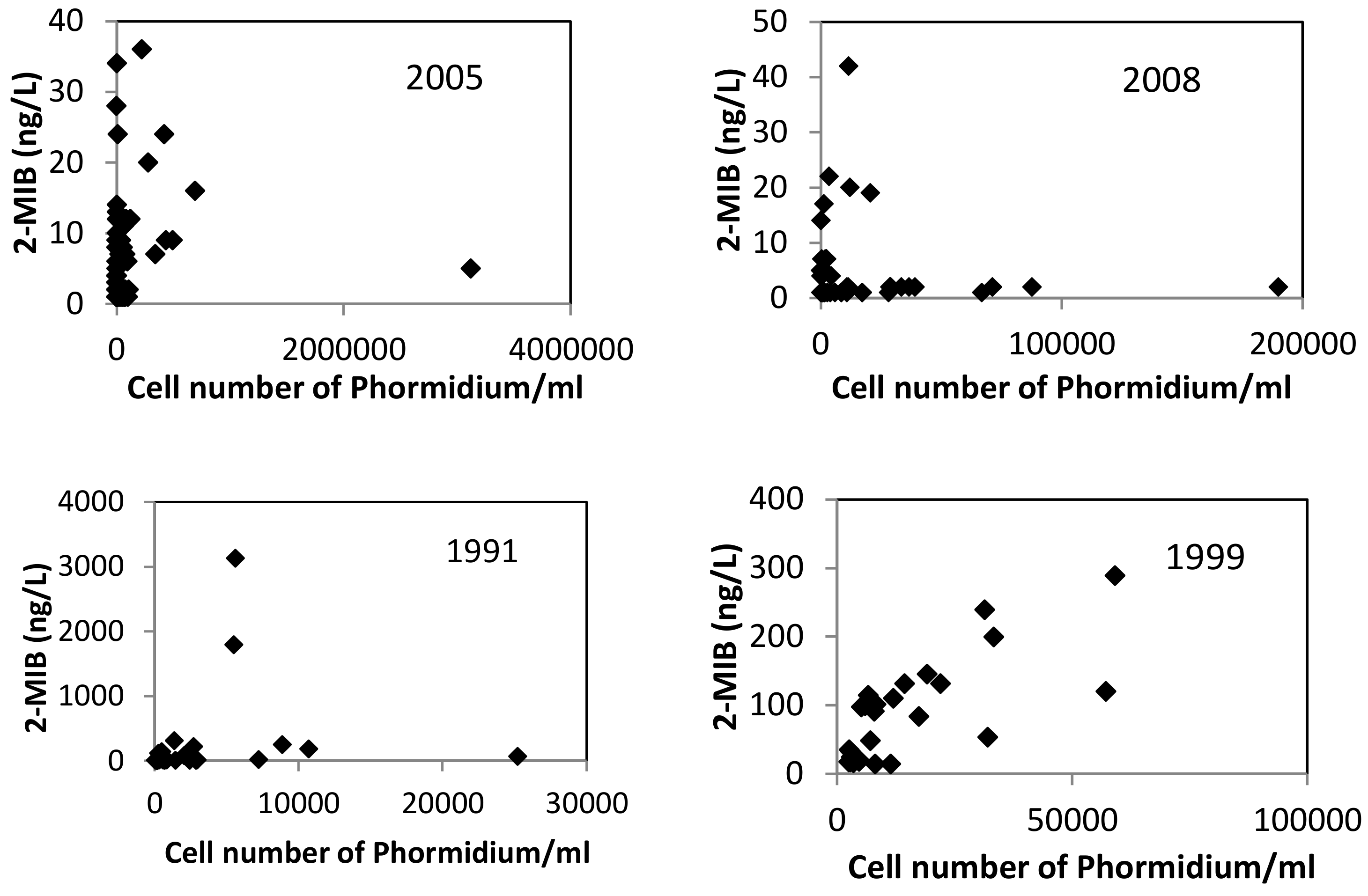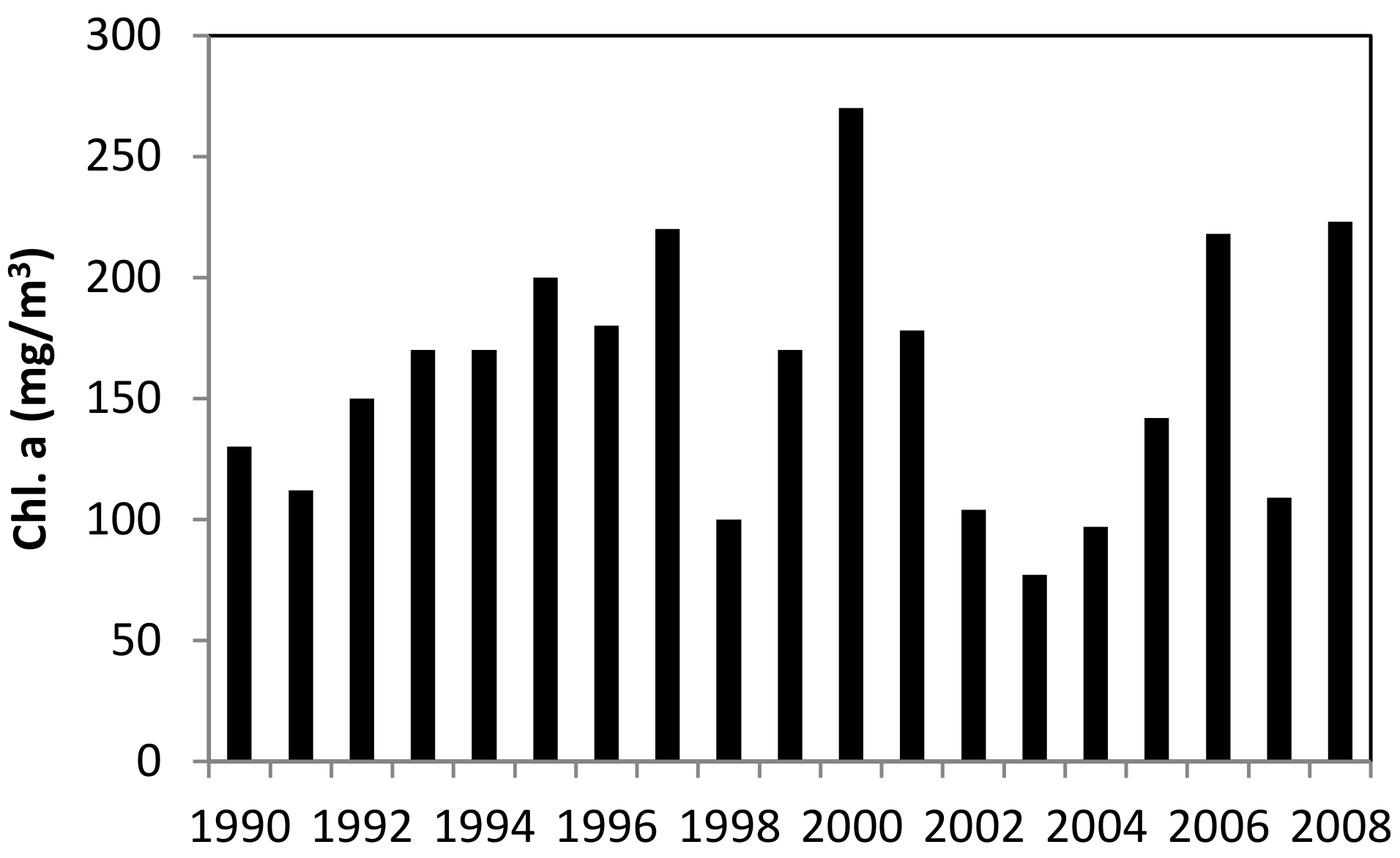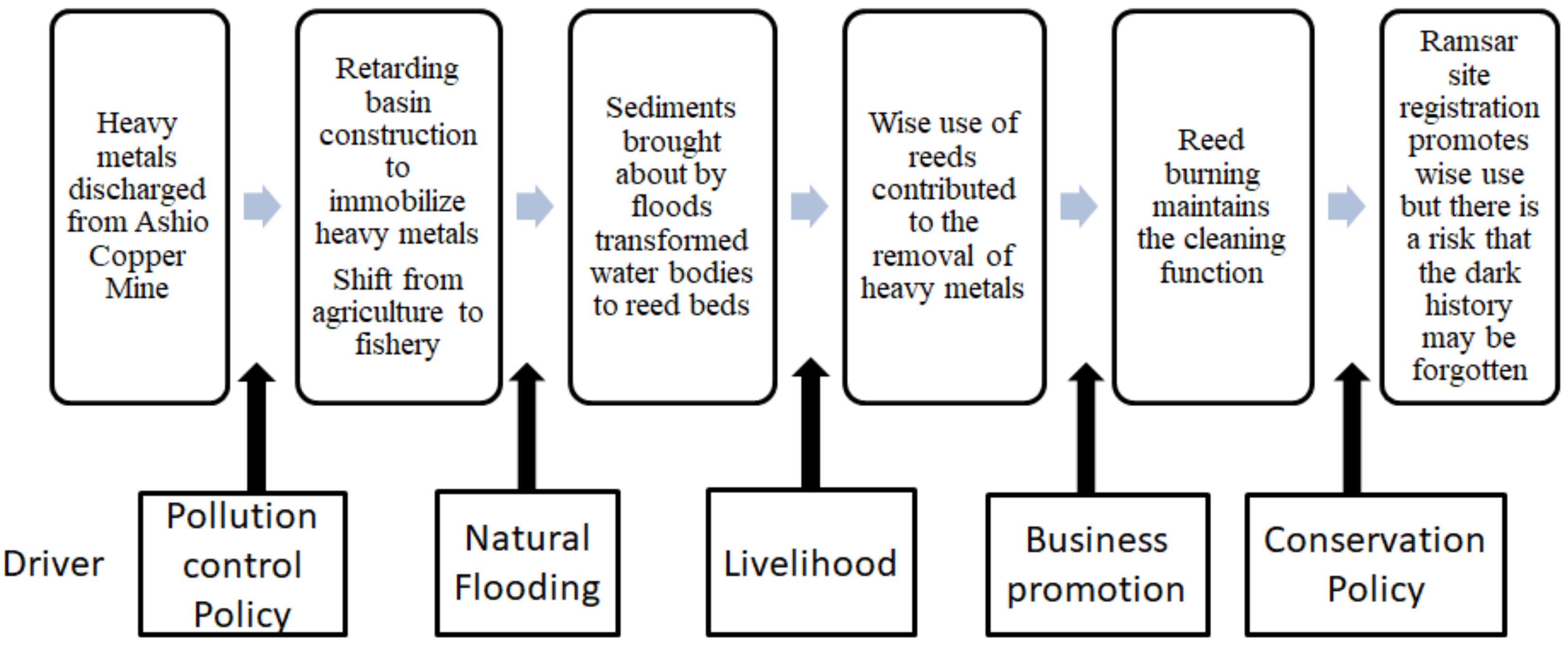3.1. Social Perspective
The history of the WRB is a direct result of the operations of the Ashio Copper Mine more than 100 years ago. Wastewater from the mine containing both heavy metals and high levels of sulfides was dumped into the Watarase River, along with the residual waste material from the ore extraction process. In 1903, the government determined that a retarding basin or catchment area be constructed to prevent the contaminated river water from moving further downstream to reach the capital city. The basin was proposed for the region between Ashio and Tokyo, with Yanaka Village ultimately identified as the appropriate site for constructing this basin [
9].
Following this decision, Yanaka Village was abandoned in 1906, along with rice cultivation in the area designated for construction of the retarding basin. As a result, paddy fields became ponds with water depths ranging from 0.3 m to 1 m. Natural and converted ponds inside the retarding basin allowed villagers who had lost their farmlands but had not left their homes to make a living from fisheries. Although fisheries-dependent livelihood in a heavy metal contaminated site was questionable and risky, this period of fishery production lasted approximately two decades [
8,
9]. There were no records about food poisoning due to the consumption of fish unloaded from the ponds within the WRB. A possible explanation is that heavy metals were adsorbed to sediments and the settling of suspended sediments removed heavy metals from water column in a pond because flow velocity is often very low in a pond, allowing sediments to settle down to the bed. Besides, a study on bioaccumulation of heavy metals in fish tissues found muscles, which are the edible part of fish, always possessed the lowest concentrations of all metals [
10]. Another study revealed that the bioaccumulation of mercury was higher in black bass than common carp [
11]. Overall, metal bioaccumulation by fish and subsequent distribution in organs is dependent on many factors including species, sex, age, size, reproductive cycle, swimming patterns, feeding behavior and geographical location [
12]. Therefore, although mercury accumulation in fish poses well-known health risks to humans, fish mercury levels can be highly variable, which may be considered another reason that fisheries in the WRB did not cause secondary disaster. The fishery inside the contaminated WRB is questionable and would be prohibited today. However, it was probably very difficult to discuss health risk 100 years ago due to the lack of sufficient scientific evidence and social awareness of health risk. Therefore, the fishery in the WRB might be wrong but it is hard to blame the fishermen and should be considered the limitation of time. Nevertheless, such a lesson should be learned and remembered to avoid the repetition of similar mistakes. In this regard, more environmental history studies on the WRB using modern technologies should be conducted, which will definitely lead to better understanding on the merits and demerits of constructing the WRB and the livelihood in it.
Around the end of the 1920s, sediments brought about by flooding accumulated in the retarding basin and turned most water bodies to wetlands. At this time, the natural seed bank resulted in the growth of a vast mass of reeds. Consequently, local people who had relied upon fisheries for the previous two decades started to make their living through sedge-hat and reed-curtain production. In the 1950s, the production of reed-curtains became mechanized, with the products used not only in households but also in Shiitake mushroom cultivation and sericulture operations. Reed-curtain production peaked in the 1970s with approximately 500,000 pieces made per year [
13]. The market price of reed-curtains at that time was 3000–5000 yen per piece (equivalent to 12,000–20,000 JPY or 100–180 USD at present), resulting in sizable profits, and more than 200 families were involved in the production [
14,
15]. From the 1980s onwards, the production of reed-products fell due to the import of reed-curtains from China, with only approximately 70,000 pieces made in 1990 [
16]. Besides, until some decades ago, reeds were also used in roof-making to some extent in Japan, but it was abandoned due to the change of life style. Today, the making of reed-curtains and other reed products in the WRB has ceased altogether.
The changes in land use in the WRB are shown in
Figure 2. The recovery of water surface area in the 1990s was due to the construction of Lake Yanaka. The increase in artificial ground is due to the construction of a sports ground and parks.
In the 1950s, to grow reeds of a high enough quality for production purposes and for reasons of pest control, reed burning was initiated. However, as the reed business decayed, the cost of reed burning became a barrier to the continuation of this practice. Further pressure to halt this practice came from the residents of newly developed residential areas near the retarding basin, who complained about the bad air quality due to the burning. However, in view of the benefits of reed burning in maintaining the quality of the reed marsh and promoting new growth of rare plant species, the management office of the Watarase River started to support the practice and, since 2000, aid reed burning in the WRB.
Since the WRB achieved Ramsar status in 2012, owing to being a place for the preservation of many endangered and endemic species, it has been viewed as an “Eco-Museum” by the general public, with the number of visitors increasing in recent years. Around half of the visitors to the WRB are local people, with another half visiting the wetland for leisure activities such as cycling or for receiving environmental education by high school students according to our interview with the staff in the Watarase Museum. This implies that visitors spend very little money in utilizing the wetland. In addition, there are no hotels inside or near the wetland, and only a few restaurants within walking distance. Furthermore, it takes about 20 min from the nearest train station to the WRB. The WRB therefore generates very little in the way of revenue from leisure and tourism due mainly to the insufficiency of attraction and poor public transport infrastructure.
Our on-site questionnaire surveys revealed that 54% of non-local visitors and 43% of the local visitors interviewed believed the environment of the wetland to be good. None of the non-local and only 7% of the local visitors considered the environment to be bad. The most astonishing difference between local and non-local visitor perceptions is that 93% of local visitors had some knowledge of the Ashio Copper Mine problem while 78% of non-local visitors had no knowledge of the history of the wetland. Non-local visitors tend to come to the WRB because it is a registered Ramsar site. When asked whether there are heavy metal residues in the wetland, one third of local visitors considered that no residues remain, one third did not know and the remaining third considered that there were residues present. When non-local visitors were asked the same question, 23% considered that no residues remain, while 61% did not know and the remaining 16% believed that there are still heavy metal residues in the wetland. These results revealed that the information on the wetland to the public, especially to the non-local, is somewhat biased by the registration of the wetland as a Ramsar site. As a result, the public perception towards the current environmental condition of the wetland is clouded.
In off-site questionnaire surveys, amongst students of the Graduate School of Global Environmental Studies, Sophia University, 77% of those asked were aware of the WRB wetland but 62% were unaware of the Ashio Copper Mine problem, even though they are majoring in environmental studies. These survey results suggest that environmental education on the history of the WRB wetland is fragmented and far from sufficient. This situation may also be attributed to the quality of information related to the WRB. Young graduate students majored in environmental studies are supposed to become environmental management leaders in the near future. If our future environmental leaders do not possess the sound and deep understanding of major pollution cases in the past, how can they be expected to perform their duty of protecting the environment in scientifically sound ways? Education for Sustainable Development (ESD) is about learning what is needed to maintain and improve our quality of life and the quality of life of generations to come. Therefore, profound knowledge on drivers that may trigger major environmental and societal changes should be a main focus of ESD and should be obtained through both in-class teaching and field-based learning.
3.2. Environmental Perspective
Despite the huge impact of pollution on society and the environment, historic data regarding heavy metals in the soil of the WRB are limited, with a lack of accurate information on specific sampling sites. The work done by Kozai [
17] indicated that the concentration of soluble Cu in affected areas ranges from 220 to 530 ppm. According to a non-profit organization, the top soil in the abandoned Yanaka Village contained concentrations of Cu of 380 ppm in 1980 [
18]. Another survey conducted at two locations within Yanaka Village in 2014 reported concentrations of soluble Cu of 105 and 219 ppm, respectively [
19].
Concentrations of heavy metals across the sampling sites obtained by our investigation were in the following ranges: Pb, 37–167 mg/kg; Cd, 0.12–13.3 mg/kg; Cu, 21.3–150.2 mg/kg; and Cr6+, 2.1–32.6 mg/kg. The levels of Cd, Cu and Cr obtained in this study were lower than the environmental standards of Japan [
20] at all sampling sites. For Pb, the environmental standard for soil is 150 mg/kg. One sample exceeded this limit and approximately 30% of samples contained concentrations higher than 100 mg/kg. Considered in the context of the historical data, the concentration of soluble Cu measured in this survey indicates the possibility that the removal rate of Cu has been accelerated in recent years.
In 2018, reed burning was carried out on 17 March. The concentrations of heavy metals in the soil before and after the reed burning are shown in
Figure 3a–c.
In
Figure 3, heavy metal concentrations were higher in the eastern and northern sides of the survey area than in the western and southern sides. This distribution is attributable to flooding, since flood waters flow into the retarding basin from the northeast, where an overflow spillway is located. The reeds reduce the flow velocity of flood waters and enhance sediment deposition. Heavy metals in the sediment are trapped by the reeds, leading to reduction of heavy metals in soil in the downstream direction, where Lake Yanaka is located. Considering the fact that the lake has the function of providing drinking water to residents downstream, the reeds provide an important cleaning function. It can also be observed in
Figure 3a–c that concentrations of heavy metals decreased after burning. Average concentrations before and after burning were 94.2 mg/kg and 65.6 mg/kg for Pb, 2.3 mg/kg and 1.4 mg/kg for Cd, and 9.6 mg/kg and 5.4 mg/kg for Cr6+, respectively. It is seen that the reduction in heavy metal concentration through reed burning is greater for Pb than Cd and Cr6+. Utilization of the Mann–Whitney U test indicated that these differences are statistically significant (
p < 0.05). It was also found that pH values had insignificant change before and after the burning but the average temperature of top soil increased from 10.8 to 25.6 °C. Burning of the reeds removes the old plants and promotes regrowth, which maintains the capacity of the reeds to trap heavy metals from the soil. Conventional in-situ soil remediation techniques include soil washing/leaching/flushing with chemical agents, chemical immobilization/stabilization by adding non-toxic materials into the soils, electrokinetic remediation, replacing or mixing the polluted soil with clean soils to reduce the concentration of heavy metals and phytoremediation using plants. The mechanism of reduction of heavy metals in soil via setting a large-scale fire on a contaminated land to enhance phytoremediation has never been reported before according to the author’s literature survey. Therefore, the present study serves as a call for further study on this removal process in relation to phytoremediation. Nevertheless, the burning of reeds may cause air pollution and discomfort to the local residents. Therefore, further study should also include the assessment of the negative aspects of reed burning and search for mitigation measures if any negative aspect is confirmed.
As shown in
Figure 4, in the 19th century, there were a number of lakes in the northern part of the retarding basin. They disappeared in the 1990s. Instead, a lake, named as Yanaka, was constructed in a heart shape in 1989 for flood regulation, drinking water supply and maintenance water supply to the downstream rivers. It has a surface area of 4.5 km
2 and an average depth of six meters with seasonal changes of about three meters. However, the lake became eutrophic quickly in the 1990s due to excessive nutrients input mainly from the Yata River. The annual peak concentration of chlorophyll a in the lake ranged from 110 to 270 µg/L in the 1990s. Consequently, the lake suffered from the musty odor problem (2-MIB), affecting the tap water quality in areas where the water from the lake was supplied. The excessive growth of
Phormidium was identified as the cause of 2-MIB [
21] and a countermeasure was taken by the lake’s administration office, which was drawing down the water level [
22]. Since 2004, ever year the water in the lake is pumped out and 80% of the lake bed is exposed to air for one and half months between January and March. As shown in
Figure 5, this water level drawdown operation results in bed desiccation, significantly decreasing the concentration of 2-MIB in the lake. The study by Kajiyama et al. [
23] indicated that bed desiccation operation significantly reduced the cell number of
Phormidium in the lake. However, the relationship between the level of 2-MIB and the cell number of
Phormidium is still poorly understood. Data scrutiny revealed that the relationship between the level of 2-MIB and the cell number of
Phormidium is complicated. As shown in
Figure 6, the relationship between the two on annual basis before and after the drawdown countermeasure varied greatly from year to year. Except 1999, a common feature to all annual variations is that the highest cell number of
Phormidium did not correspond to the highest level of 2-MIB. A further look into the data found that a significant difference between the two periods is that the cell number of
Phormidium at the time of annual maximum 2-MIB ranged 400–900,000/mL before the drawdown while it ranged 7000–110,000/mL afterwards. In 1991, the cell number of
Phormidium was 5630/mL when 2-MIB reached to its highest ever value, 3130 ng/L. This observation led to a hypothesis that the water level drawdown delayed the growth of
Phormidium, which resulted in less release of 2-MIB from the cells of
Phormidium. The relationship between 2-MIB and water temperature was also examined and correlation was not found. It should also be pointed out here that 2-MIB was still present in the lake after the drawdown and there were days when the level of 2-MIB exceeded Japan’s environmental standard for 2-MIB although the level was significantly lower than that before the start of drawdown. The standard of 2-MIB in public waters is 10 ng/L in Japan. Although the smell in water leads to frequent complaints from consumers, 2-MIB-related health risk or cytotoxicity has been very much undocumented thus far. Besides, as shown in
Figure 7, the annual peak concentration of chlorophyll a in the lake was not reduced by the drawdown operation. Therefore, further study is needed to better understand the mechanism of odor generation and its health risk, better quantify the effectiveness of water level drawdown operation in dealing with the problem and better manage the eutrophication process of the lake.
It should also be mentioned here that there has not been any large-scale coordinated investigation on the soil and water environment downstream of the WRB to evaluate the effectiveness of the WRB in stopping the contamination since its construction. The fact that there have been no complaints from the communities downstream of the WRB on heavy contamination is considered as good evidence of effective control of heavy metals by the WRB. A study on the distribution of heavy metals in the bottom sediment of the Watarase River showed that concentrations of heavy metals decreased very significantly from upstream to downstream before it joins the Tone River [
26]. Although more than 100 years elapsed, an in-depth re-visit to the effectiveness of the WRB to control the pollution is worth conducting.
